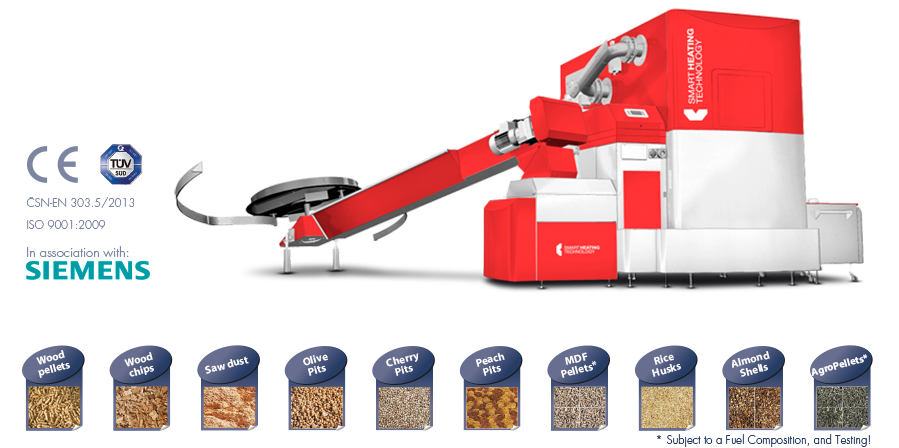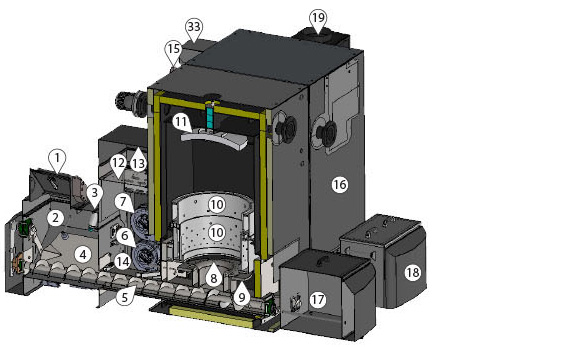| SMART BOILERS OPERATING DATA |
| Marking |
|
150 |
| Nominal power Pn |
kW |
150 |
| Partial load (power) Pp |
kW |
40 |
| Boiler efficiency at Pn |
% |
>95 |
| Boiler class |
|
5 |
| Water volume |
l |
380 |
| Diameter of water connection |
“ |
3 |
| Diameter of water connection |
DN |
80 |
Hydraulic-pressure drop of the boiler
at the temperature fall 20° |
mbar
|
65
|
| Boiler temperature |
°C |
60–90° |
| Minimal temperature of returnable water |
°C |
55 |
| Maximal operational pressure |
bar |
3,5 |
| Test pressure |
bar |
6,5 |
| Temperature of furnace |
°C |
900–1100 |
| Pressure of furmace |
mbar |
-0,04 |
| Required draught of the chimney |
mbar |
0,2 |
| Requirement for the forced draught |
|
Yes |
| Combustion temperature at Pn |
°C |
96,6 |
| Combustion temperature at Pp |
°C |
63,1 |
| Diameter of flue gas duct |
mm |
220 |
| Diameter of chimney |
mm |
250 |
| Wood pellets – C1 |
Tested
fuel |
D6, M10, A1,5, DU90,0 |
| Wood chips – B1 |
P45, M30, A3.0 |
| Electrical connection |
|
3+N+PE 50Hz 230/400V TN-C-S |
| Conveyor engine |
W |
550 |
| Feeding auger engine |
W |
550 |
| Exchanger cleaning engine (s) |
W |
550 |
| Ash-removing engine |
W |
550 |
| Fan of primary air |
W |
66 |
| Fan of secondary air 1 |
W |
66 |
| Fan of secondary air 2 |
W |
66 |
| Chimney exhaust fan |
W |
300 |
| Electrical ignition |
W |
1600 |
| Separation flap valve |
W |
6,5 |
|
| Wood pellets |
Wood chips |
| Rated |
Minimum |
Rated |
Minimum |
| Rated heat capacity |
kW |
150 |
150 |
150 |
150 |
Combustion product
temperature |
°C
|
116,1
|
72,4
|
96,6
|
63,1
|
| Fuel consumption |
kg/hour |
36,30 |
9,78 |
37,18 |
9,45 |
| Input water temperature |
°C |
60,2 |
67,1 |
60,3 |
62,4 |
| Outlet water temperature |
°C |
80,5 |
85,2 |
78,8 |
79,2 |
| Cooling water temperature |
°C |
9,6 |
11,1 |
9,6 |
11,0 |
| Cooling water flow rate |
m3/hod |
6,733 |
2,033 |
7,080 |
1,950 |
| Draught behind boiler |
Pa |
125,0 |
35,0 |
125,0 |
35,0 |
| Ambient temperature |
°C |
24,0 |
26,3 |
24,2 |
22,6 |
| Relative air humidity |
% |
45,3 |
44,7 |
38,6 |
37,2 |
| Barometric pressure |
kPa |
99,23 |
99,24 |
99,10 |
99,20 |
| Oxygen O2 |
% |
8,12 |
12,66 |
8,08 |
11,40 |
| Carbon dioxide CO2 |
% |
11,37 |
7,28 |
11,61 |
8,70 |
| Carbon monoxide CO |
ppm |
46 |
175 |
100 |
146 |
| Higher hydrocarbons OGC |
ppm |
4 |
2 |
3 |
5 |
| Nitrogen dioxides Nox |
ppm |
81 |
47 |
83 |
55 |
| Dust |
mg/m3 |
28 |
17 |
52 |
41 |
| Carbon monoxide CO |
mg/m3 |
49 |
289 |
106 |
209 |
| Higher hydrocarbons OGC |
mg/m3 |
2 |
1 |
1 |
3 |
| Nitrogen dioxides Nox |
mg/m3 |
143 |
126 |
144 |
130 |
| Dust |
mg/m3 |
24 |
23 |
44 |
47 |
| Mass flow rate gases |
kg/sec |
0,109 |
0,044 |
0,099 |
0,033 |
| Stoichiometric oxygen value |
m3/kg |
0,957 |
0,957 |
0,832 |
0,832 |
| Stoichiometric air value |
m3/kg |
4,559 |
4,556 |
3,963 |
3,960 |
| Stoichiometric volumeof dry combustion products |
m3/kg
|
4,448
|
4,445
|
3,884
|
3,881
|
| Stoichiometric air multiple |
|
1,61 |
2,48 |
1,61 |
2,16 |
| Volume of dry combustion products, actual |
m3/kg |
7,436 |
11,573 |
6,474 |
8,622 |
| Volume of H2O in the combustion air |
m3/kg |
0,102 |
0,177 |
0,076 |
0,089 |
| Volume of H2O in the combustion produts |
m3/kg |
0,956 |
1,032 |
0,922 |
0,935 |
| Maximum volume CO2 |
% |
19,01 |
19,01 |
19,37 |
19,37 |
| Loss of sensible heat of combustion products (chimney) |
% |
6,4
|
4,7
|
4,8
|
3,5
|
| Loss of gas underburning |
% |
0,0 |
0,2 |
0,1 |
0,1 |
| Loss of mechanical underburning |
% |
0,1 |
0,1 |
0,3 |
0,3 |
| Loss of heat transfer into the environment |
% |
0,8 |
1,1 |
0,8 |
2,1 |
| Total loss |
% |
7,3 |
6,1 |
6,0 |
6,0 |
| Efficiency – indirect method |
% |
92,7 |
93,9 |
94,0 |
94,0 |
| Heat input |
kW |
167,0 |
45,0 |
158,9 |
40,4 |
| Heat capacity |
kW |
159,2 |
43,0 |
152,0 |
38,4 |
| Uncertainty of determining heat capacity |
% +/- |
6,7 |
1,8 |
6,4 |
1,6 |
| Efficiency – direct method |
% |
95,3 |
95,6 |
95,6 |
95,1 |
| Capacity / rated output |
% |
106,1 |
28,7 |
101,3 |
25,6 |
|








